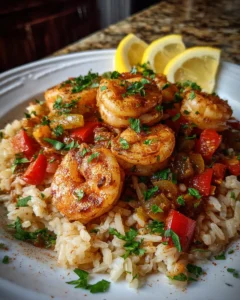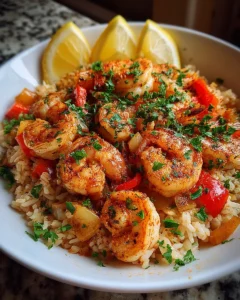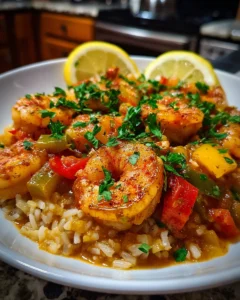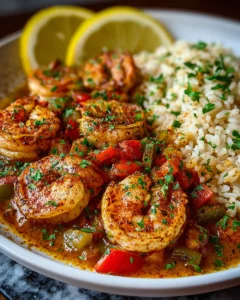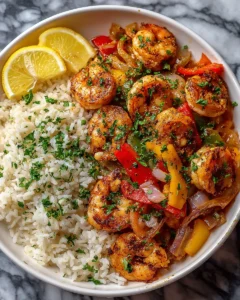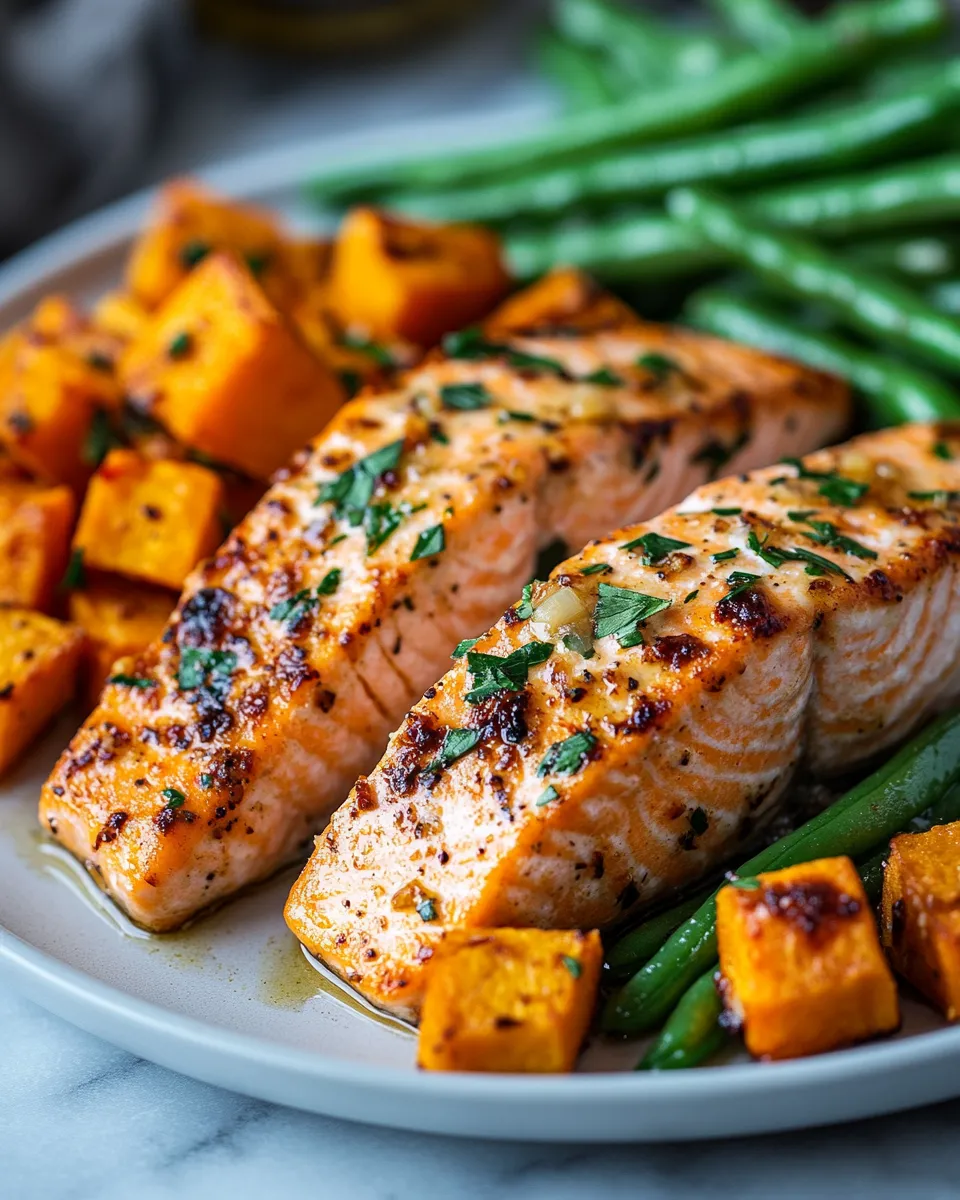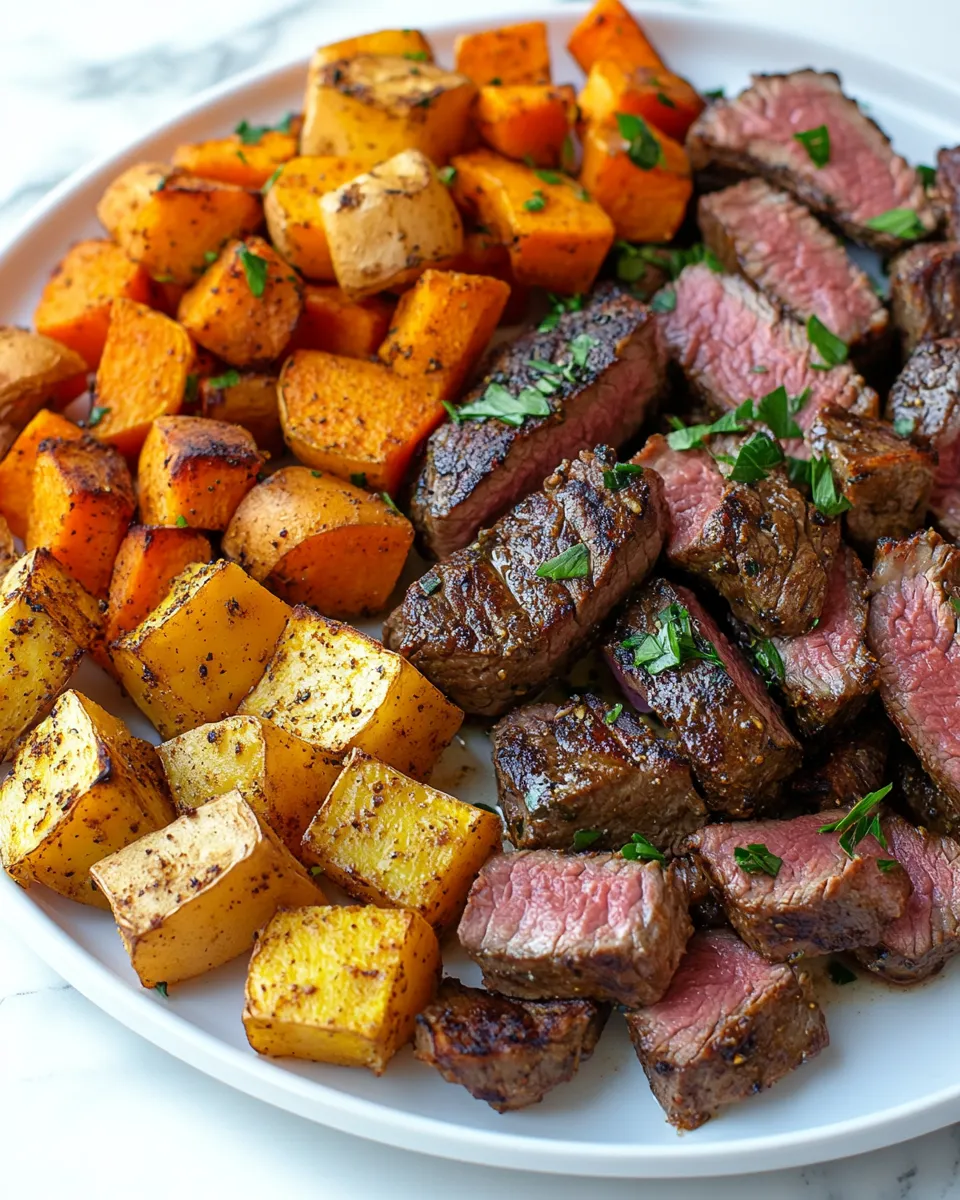There’s nothing quite like the aroma of a perfectly spiced Cajun dish wafting through the kitchen, promising a bold and satisfying meal. Spicy Cajun Shrimp and Rice Skillet is a recipe that brings together tender shrimp, vibrant spices, and perfectly cooked rice in a one-pan wonder that is both comforting and exciting. Ideal for a cozy weeknight dinner, a weekend family feast, or even a casual summer gathering, this dish is a celebration of flavor in every bite.
Inspired by the rich culinary traditions of Louisiana, this recipe combines the fiery zest of Cajun seasoning with the subtle sweetness of shrimp and the heartiness of fluffy rice. It’s a dish that evokes memories of lively dinner tables, warm laughter, and the irresistible call of Southern cuisine. Whether you’re a seasoned chef or a home cook looking for a simple yet impressive meal, this Cajun Shrimp and Rice Skillet is sure to delight both your taste buds and your guests.
Ingredients
To make this Spicy Cajun Shrimp and Rice Skillet, you’ll need simple, fresh ingredients that combine to create a flavorful, hearty meal. Here’s what you’ll need:
For the Shrimp:
-
1 pound large shrimp, peeled and deveined
-
2 tablespoons olive oil
-
1 tablespoon Cajun seasoning (store-bought or homemade)
-
1 teaspoon smoked paprika
-
1/2 teaspoon garlic powder
-
Salt and black pepper to taste
For the Rice Skillet:
-
1 cup long-grain white rice, rinsed
-
2 cups chicken or vegetable broth
-
1 medium onion, finely diced
-
1 red bell pepper, diced
-
1 green bell pepper, diced
-
2 celery stalks, diced
-
3 cloves garlic, minced
-
1 can (14 oz) diced tomatoes, drained
-
1 teaspoon dried thyme
-
1 teaspoon dried oregano
-
1/2 teaspoon crushed red pepper flakes (adjust to taste)
-
2 tablespoons fresh parsley, chopped (for garnish)
-
Optional: 1/2 teaspoon cayenne pepper for extra heat
Step-by-Step Instructions
1. Prepare the Shrimp
The first step in creating a flavorful Spicy Cajun Shrimp and Rice Skillet is to properly season your shrimp. Start by peeling and deveining 1 pound of large shrimp if they aren’t prepped already. Pat them dry with paper towels to remove excess moisture—this helps the seasoning stick and ensures a perfect sear.
In a medium-sized bowl, toss the shrimp with 1 tablespoon of Cajun seasoning, 1 teaspoon smoked paprika, 1/2 teaspoon garlic powder, and a pinch of salt and freshly ground black pepper. Take your time to coat each shrimp evenly. The seasoning mix is essential, as it infuses the shrimp with the bold, spicy flavor that defines Cajun cooking. If you like a little extra heat, you can also sprinkle in some cayenne pepper at this stage.
Heat 2 tablespoons of olive oil in a large skillet over medium-high heat. The oil should shimmer but not smoke. Add the shrimp in a single layer, giving them enough space so they sear rather than steam. Cook for 2-3 minutes per side until the shrimp turn pink, slightly opaque, and develop a light golden caramelization. Be careful not to overcook; shrimp become rubbery if left too long. Once cooked, transfer the shrimp to a plate and set aside while you prepare the rest of the dish.
2. Sauté the Vegetables
In the same skillet, add a touch more olive oil if the pan looks dry. Begin by sautéing 1 finely diced onion, 1 red bell pepper, 1 green bell pepper, and 2 celery stalks, diced. Stir occasionally for about 5 minutes, allowing the vegetables to soften and release their natural sweetness. This mixture forms the aromatic base that complements the shrimp and rice perfectly.
Next, add 3 cloves of minced garlic and cook for an additional 1-2 minutes. Garlic cooks quickly, so watch carefully to prevent burning. The combination of sautéed onions, bell peppers, celery, and garlic builds a depth of flavor that elevates this one-pan meal into something truly memorable.
3. Cook the Rice
Once the vegetables are tender and fragrant, stir in 1 cup of rinsed long-grain white rice, ensuring each grain is coated in the flavorful vegetable mixture. Pour in 2 cups of chicken or vegetable broth, then add 1 can of diced tomatoes (drained), 1 teaspoon dried thyme, 1 teaspoon dried oregano, and 1/2 teaspoon crushed red pepper flakes. Stir to combine. If you prefer extra heat, sprinkle in some cayenne pepper at this stage.
Bring the mixture to a gentle boil, then reduce the heat to low and cover the skillet. Let it simmer for 15-20 minutes, or until the rice is tender and has absorbed all the liquid. Avoid lifting the lid too often, as this can release steam and affect the cooking process.
4. Combine Shrimp and Rice
When the rice is perfectly cooked, return the shrimp to the skillet. Gently fold them into the rice and vegetable mixture, taking care not to break the shrimp apart. Let the shrimp warm through for 2-3 minutes, allowing the spices and juices from the shrimp to meld into the rice. Taste and adjust seasoning if necessary, adding extra salt, pepper, or a pinch of cayenne to suit your preference.
5. Garnish and Serve
Finish the dish by sprinkling 2 tablespoons of freshly chopped parsley over the top. The green garnish adds a pop of color and a hint of freshness that balances the richness of the Cajun flavors. Serve the skillet immediately, either straight from the pan for a rustic, family-style presentation or plated individually for a more refined approach. The combination of perfectly seasoned shrimp, tender rice, and vibrant vegetables creates a comforting and visually appealing meal that’s sure to impress.
Tips for Perfect Cajun Shrimp
-
Choose Fresh or Properly Thawed Shrimp – For the best texture, always use fresh shrimp or fully thaw frozen shrimp in the refrigerator overnight. Pat them dry to ensure a perfect sear.
-
Don’t Overcook – Shrimp cook quickly. Overcooked shrimp become rubbery, so remove them from heat as soon as they turn pink and opaque.
-
Layer the Flavors – Sautéing vegetables first and using a mix of herbs and spices ensures your rice and shrimp are bursting with flavor in every bite.
-
Adjust Spice Levels – Cajun seasoning can be spicy. Taste as you go and adjust with cayenne or crushed red pepper to suit your preference.
Understanding Cajun Spices
Cajun cuisine is all about bold, balanced flavors. The key spices include:
-
Paprika – Adds a sweet smokiness to dishes.
-
Cayenne Pepper – Provides the heat that Cajun dishes are known for.
-
Garlic Powder – Enhances the savory depth of the recipe.
-
Onion Powder – Rounds out the aromatic base.
-
Dried Thyme & Oregano – Bring earthy, herbal notes.
Combining these spices carefully allows you to replicate authentic Cajun flavors without overwhelming your taste buds.
Perfect Side Dishes for Cajun Shrimp and Rice
While the skillet is a complete meal on its own, pairing it with the right sides can elevate the dining experience:
-
Cornbread – Sweet and slightly crumbly, it balances the spicy shrimp perfectly.
-
Steamed or Roasted Vegetables – Broccoli, green beans, or asparagus add freshness and texture.
-
Simple Green Salad – A crisp salad with a light vinaigrette cuts through the richness of the rice and shrimp.
-
Garlic Bread – Perfect for soaking up the flavorful sauce in the skillet.
Serving Suggestions
-
Serve directly from the skillet for a rustic, family-style presentation.
-
For a more elegant presentation, plate individual servings in shallow bowls and garnish with extra parsley or a wedge of lemon for brightness.
-
Pair with a crisp white wine like Sauvignon Blanc or a light, fruity beer for a casual dinner party.
Storage and Make-Ahead Tips
-
Refrigeration – Store leftovers in an airtight container in the refrigerator for up to 3 days. Reheat gently on the stove or in the microwave to avoid overcooking the shrimp.
-
Freezing – While rice and shrimp can be frozen separately, it’s best to freeze the rice mixture without shrimp. Add freshly cooked shrimp when reheating to maintain texture.
-
Meal Prep – This recipe is perfect for meal prep. Cook the rice base ahead of time and store in portions. Add freshly cooked shrimp when ready to serve.
Frequently Asked Questions
1. Can I use frozen shrimp?
Yes! Frozen shrimp can work beautifully in this recipe, but there are a few important steps to follow. First, thaw the shrimp completely in the refrigerator—this may take several hours or overnight depending on the quantity. Avoid thawing at room temperature, as this can promote uneven cooking and bacterial growth. Once thawed, pat the shrimp dry with paper towels. Removing excess moisture is crucial because wet shrimp will steam rather than sear, preventing that beautiful caramelized exterior that gives the dish its signature flavor. After drying, proceed with seasoning and cooking as usual.
2. How spicy is this dish?
The level of spice in this skillet can vary depending on the Cajun seasoning you choose and whether you add optional cayenne pepper or crushed red pepper flakes. Store-bought Cajun seasoning ranges from mild to fiery, so it’s important to taste and adjust. If you prefer a milder version, reduce the cayenne and red pepper flakes. For those who love a serious kick, you can increase the amount of cayenne or even add a few dashes of hot sauce. Remember, the vegetables and rice help balance the heat, making it flexible for different taste preferences.
3. Can I make this recipe ahead of time?
Absolutely! This meal is perfect for meal prep or make-ahead dinners. You can prepare the rice and sautéed vegetable mixture in advance and store it in an airtight container in the refrigerator for up to two days. When you’re ready to serve, cook the shrimp fresh and fold them into the warmed rice and vegetables. Cooking the shrimp fresh ensures they stay tender and juicy, rather than rubbery, while the flavors of the rice and vegetables remain vibrant.
4. Can I substitute white rice with brown rice or quinoa?
Yes, substitutions are possible, but cooking times and liquid amounts will need to be adjusted. Brown rice typically requires more broth and a longer simmering time, around 35–40 minutes, to become tender. Quinoa cooks faster, usually in 15 minutes, and has a slightly nuttier texture that can add a unique twist to the dish. Make sure to monitor the liquid and fluff the grains carefully for the best results.
5. Can I make this dish vegetarian?
Definitely! For a vegetarian version, replace the shrimp with firm tofu, tempeh, or a mix of hearty vegetables such as mushrooms, zucchini, or even eggplant. Sear the tofu or vegetables similarly to shrimp to get a nice crust and fold them into the rice and vegetable mixture. You can also add extra spices to mimic the smoky, bold flavors of Cajun cuisine, ensuring the dish remains satisfying and full of flavor for plant-based eaters.

